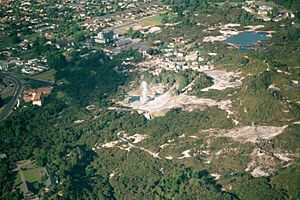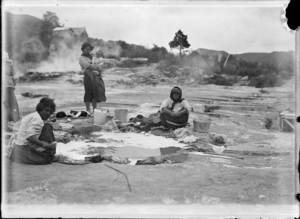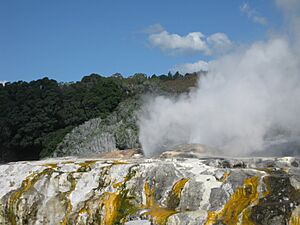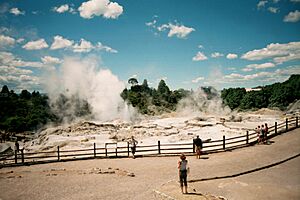Whakarewarewa facts for kids
Quick facts for kids
Whakarewarewa
|
|
|---|---|
|
Suburb
|
|

Aerial view of Whakarewarewa; Pohutu Geyser is erupting.
|
|
| Country | New Zealand |
| Local authority | Rotorua Lakes |
| Electoral ward | South |
| Population
(2018)
|
|
| • Total | 771 |
| Springfield | Glenholme | Ngāpuna |
|
|
||
Whakarewarewa is a special place in Rotorua, New Zealand. Its full name, Te Whakarewarewatanga O Te Ope Taua A Wahiao, means The gathering place for the war parties of Wahiao. Locals often call it Whaka for short. This area is famous for its amazing geothermal features, like hot springs and geysers.
For a very long time, since about 1325, the Māori have lived here. They built a strong fortress called Te Puia, which was so powerful it was never captured in battle. The Māori people have always used the natural heat from the earth for cooking and warming their homes.
Whakarewarewa has about 500 hot pools and at least 65 geyser vents, each with its own name. Seven of these geysers are still active today. The most famous is Pohutu Geyser, which means "big splash" or "explosion." It erupts about once an hour, sending water up to 30 meters high!
Years ago, people in Rotorua used to dig shallow wells to get hot water for heating. This caused some of the geysers and hot springs at Whakarewarewa to become less active. But in 1987-1988, many of these wells were closed. After that, the geysers and hot springs started to recover and become active again.
The area is also home to Te Pākira Marae and Wahiao meeting house. These are important meeting places for several Māori groups, including the Tūhourangi people.
Contents
Amazing Geysers of Whakarewarewa
Most of the active geysers at Whakarewarewa are found on a spot called Geyser Flat. They are all connected underground, so what one geyser does can affect the others!
Kereru Geyser
Kereru Geyser is located near the Puarenga Stream. It erupts every few days or weeks, shooting water up to 15 meters high in a fan shape. This geyser became much more active after the wells in the area were closed in 1987.
Geysers on Sinter Plateau
Several important geysers are found on a raised area called a sinter plateau. These include Prince of Wales Feathers Geyser, Pohutu Geyser, Te Horu Geyser (The Cauldron), and Waikorohihi Geyser.
- Prince of Wales Feathers Geyser: This geyser is very close to Pohutu. It always starts erupting before Pohutu does. It begins with a small jet that slowly gets stronger, shooting a continuous stream of water up to 9 meters high. When it reaches this point, Pohutu usually erupts too.
- Waikorohihi Geyser: Sometimes, Waikorohihi Geyser erupts first, sending water up to 5 meters high. After it stops, Prince of Wales Feathers Geyser might start, and then Pohutu will follow.
- Te Horu Geyser (The Cauldron): This geyser used to erupt often, but it stopped in 1972. The water in its vent started to overflow again in 1998. Te Horu and Pohutu are very connected. When Pohutu erupts, some of its water falls back into Te Horu, which can cool the system and affect when Pohutu erupts next. This is why some people think Pohutu is more active when there's a south wind, as the wind blows the water away instead of letting it cool the system.
Other Notable Geysers
- Mahanga Geyser: Also known as the Boxing Glove, this geyser wasn't known to erupt until 1961. Its eruptions, which reach 3 to 4.5 meters high, happen on their own, not connected to nearby geysers.
- Wairoa Geyser: This geyser was once famous for erupting up to 60 meters high! It last erupted naturally in 1940. After that, its water level dropped, and the water became acidic. However, in 1996, its water level rose again, and it has been boiling powerfully ever since.
- Waikite Geyser: Located a bit further away, Waikite Geyser last erupted in 1967. Since then, its vent has been dry and only steaming a little. In 1996, its deep vent suddenly filled with boiling water! It's hoped that Waikite might erupt again someday, especially after long periods of heavy rain.
- Pareia Geyser: This geyser, located near Waikite, has recently become active again.
- Papakura Geyser: This is another important geyser that was dormant for a long time. It last erupted in September 2015, after not erupting for 110 years, except for a few very brief times. The fact that Papakura stopped erupting led to a program in 1981 to monitor the geothermal activity in Rotorua.
Images for kids
-
A fumarole














